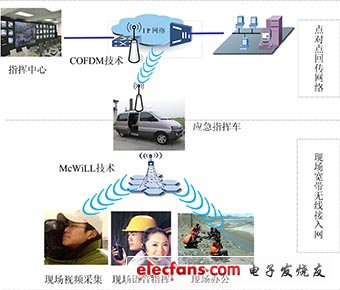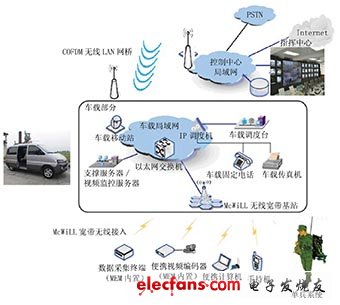1 Introduction
Emergency communication support is an important part of the national emergency management system. When the communication network facilities are damaged, performance is degraded, or when the country ’s public safety, especially public emergencies and other special communication support tasks are involved, emergency communication All play an irreplaceable role. The realization of the electric power emergency communication system is a new issue proposed by the development of the power grid, and it is still in the stage of research and exploration. Because emergencies are characterized by uncertainty and emergency, the time and place of the incident cannot be predicted in advance, the existing communication network cannot ensure that there is an emergency need, and the command center and relevant departments cannot timely and fully understand the relevant situation. It is difficult to give orders and command coordination, so the construction of electric power emergency communication system needs to be improved and improved urgently. Therefore, it is necessary to build a complete power emergency communication system to support on-site video backhaul and voice communication to ensure the mobilization of different departments in the shortest time, coordinated operations, and an orderly, rapid, and efficient response to emergencies.
In the traditional emergency command system, there is a single means of personal communication, and only simple voice functions can be provided between the communication vehicle and the individual. In order to solve the shortcomings of the traditional emergency communication scheme, this paper proposes to rely on the local integrated data network and adopt the national communication standard and international communication standard McWiLL broadband wireless communication technology (national communication standard number YD / T 1989-2009; international communication standard number M.1801 )s solution. It is used in the power emergency command system through video transmission to provide emergency command communication means for power failure repairs in case of power grid emergencies, and provides a quick emergency communication method for business departments such as production systems and marketing systems to realize emergency command information. Access to a unified emergency command platform, real-time and visual transmission of decision-making information and emergency information to improve the grid's ability to respond to emergencies.
2 Design requirements for power emergency communications
With the growing national economy, the research on various high standards in the power grid has been strengthened, and more and more production business and management information are available. This puts higher requirements on the grid's ability to deal with unexpected accidents. Therefore, research and application of the "emergency communication system" for emergency repairs of power grids to realize the visualization of the entire process of emergency command and emergency rescue scenes, facilitate commanding, and improve the efficiency of emergency repairs are the top priorities for the research and application of power grid communications. Electric power emergency communication usually contains two meanings:
(1) Emergency recovery of power communication failure. It refers to the use of temporary wireless transmission methods to return data such as automation of remote substations when there is no looped fiber link failure, ensuring that the substation can operate normally during the repair of optical cables.
(2) Emergency command at the scene of electric power accident. It means that when an emergency occurs, the emergency command vehicle can be driven to the vicinity of the accident site, the repair personnel can enter the accident site alone, and communicate with the emergency command vehicle through the emergency communication terminal, and the communication system of the command vehicle can carry out various kinds of scenes. Cluster communication and dispatch command of personnel. The on-site emergency command vehicle can contact the rear command center through a certain backhaul network technology to build a complete emergency command system.
Only by comprehensively considering these two kinds of emergency needs and using different emergency communication methods in different emergencies can we provide protection for various businesses carried out by the power system and play the true role of the power emergency communication system.
3 Overall plan
Unlike pure "emergency communications", power emergency emphasizes the application of video. The power emergency communications system has got rid of the situation that only departments can handle incidents by telephone in the past. Emergency command centers at all levels can understand the emergency scene at the first time. The actual situation, this kind of visual command greatly improved the level of power emergency response. The transmission of video signals in power emergency communication systems places high demands on communication links. Therefore, how to ensure the reliability of communication links is a technical problem that must be solved in the construction of power emergency video systems. At present, after many years of internal information construction, the power system has a large-capacity and long-distance optical fiber backbone network, basically achieving fiber optic networking of offices, offices, and stations. The power fiber comprehensive data network has a large bandwidth and can be used to carry large capacity. The transmission of video and audio data provides a high-speed, broadband backbone transmission channel. At the same time, due to the large coverage of wireless communication network, convenient construction and low cost, it also has good feasibility and practicality in the power system. Therefore, the construction of an electric power emergency communication system based on the combination of fiber optic wired communication and wireless communication is the power sector. The best way to carry out emergency video transmission.
The power emergency wireless communication system consists of a point-to-point backhaul communication network and a broadband wireless access network (see Figure 1).

Figure 1 System hierarchy diagram
3.1 Point-to-point backhaul network
The emergency command communication vehicle is connected to the command center through the backhaul network to ensure that the on-site communication terminal can access the business server and related database located in the command center information network through the communication vehicle. This solution uses COFDM (Coded Orthogonal Frequency Division MulTIplexing, short for Coded Orthogonal Frequency Division Multiplexing) technology to achieve backhaul, and is currently the world's most advanced and most promising modulation technology. Its practical value lies in supporting applications that break through the line-of-sight limitation. It is a technology that makes full use of radio spectrum resources and has a good immunity to noise and interference. The backhaul access point can select the nearest substation or power branch office with optical fiber and normal communication. COFDM technology can realize the real-time transmission of high-speed wireless network data under "high-speed movement" and "non-visual conditions", and can complete single- and two-way network integrated services such as transmission of voice, data, and images under "moving and blocking conditions". It is the best choice for broadband wireless access backhaul network.
3.2 On-site broadband wireless access network
Emergency site command communication vehicle, equipped with emergency lift pole, McWiLL base station and its core network system, establishes broadband wireless access network signal coverage in the fault site area through McWiLL base station, and constructs integrated access to voice, video and data for emergency repairs at the accident site Into the communication channel, the fault site information can be effectively returned to the emergency site command communication vehicle for on-site command. Within the coverage of the McWiLL wireless local access network, each rescue team can carry a single soldier system for on-site work. The wireless notebooks, PDAs, and mobile phones carried by nearby staff can be used through the single soldier system. On-site analysis and reporting within the group. The rescue team composed of the individual soldier system as the communication center provides flexible networking and working methods for the power emergency wireless communication system, and improves the grid's ability to respond to emergencies (see Figure 2).

Figure 2 Working diagram of electric emergency system
In emergency communication applications, only the use of effective, high-speed, and safe wireless communication technology can truly give play to the characteristics of rapid response and accurate handling of emergency command systems. McWiLL broadband wireless access technology has wide coverage, high access rate, and easy expansion. , Strong anti-multipath interference capability.
Super Silent Perkins Diesel Generator
Perkins Genset,Super Silent Perkins Diesel Generator,Perkins Silent Diesel Generator,200Kva Super Silent Generator Perkins
Jiangsu Lingyu Generator CO.,LTD , https://www.lygenset.com